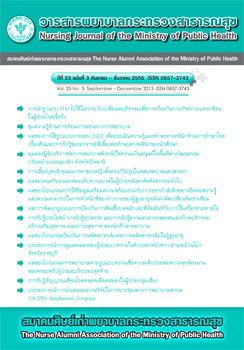ผลของโปรแกรมป้องกันการพลัดตกหกล้มต่อการพลัดตกหกล้มในผู้สูงอายุ
Main Article Content
Abstract
ประชากรผู้สูงอายุไทยมีแนวโน้มสูงขึ้น ความเสี่ยงสำคัญที่ทำให้ผู้สูงอายุได้รับบาดเจ็บหรือเสียชีวิต และเกิด ผลกระทบด้านจิตสังคม คือ การพลัดตกหกล้ม การวิจัยแบบกึ่งทดลองนี้มีวัตถุประสงค์เพื่อศึกษาผลของการใช้ โปรแกรมป้องกันการพลัดตกหกล้มต่อจำนวนครั้งของการพลัดตกหกล้มในผู้สูงอายุ กลุ่มตัวอย่างเป็นผู้สูงอายุ ที่อาศัยในชุมชน ตำบลแม่ข้าวต้ม อำเภอเมือง เชียงราย ระหว่างเดือนเมษายนถึงมิถุนายน พ.ศ. 2556 มี ประวัติการพลัดตกหกล้ม แบ่งเป็น กลุ่มทดลอง จำนวน 23 คน และกลุ่มควบคุม จำนวน 23 คน จัดให้แต่ละคู่มี ความใกล้เคียงในเรื่องเพศ อายุ และความแข็งแรงของกล้ามเนื้อและการทรงตัว เครื่องมือที่ใช้ในการทดลอง คือ โปรแกรมป้องกันการพลัดตกหกล้ม ประกอบด้วย 1) การให้ความรู้เกี่ยวกับปัจจัยเสี่ยงและแนวทางการป้องกัน การพลัดตกหกล้ม 2) การออกกำลังกายแบบไท่ชี่ 3) การทบทวนแผนการรักษาโดยการใช้ยา 4) การประเมินและ การแก้ไขปัญหาเกี่ยวกับการมองเห็น 5) การประเมินและการจัดการสิ่งแวดล้อมให้ปลอดภัย โปรแกรมป้องกัน การพลัดตกหกล้ม พัฒนาจากการค้นหาสถานการณ์ปัญหาโดยการสนทนากลุ่มของผู้สูงอายุในชุมชน จากนั้นจัด กลุ่มเรียนรู้แบบมีส่วนร่วมระหว่างผู้สูงอายุและพยาบาลที่มีความรู้เกี่ยวกับการพลัดตกหกล้ม ก่อนนำประเด็น ความคิดเห็นสู่การร่างโปรแกรม และหาความตรงด้านเนื้อหาจากผู้ทรงคุณวุฒิ ได้ค่าดัชนีความตรงตามเนื้อหา เท่ากับ .94 จากนั้นปรับปรุงโปรแกรม แล้วทดลองใช้กับผู้สูงอายุที่มีลักษณะใกล้เคียงกับกลุ่มตัวอย่างก่อนดำเนิน การวิจัย เครื่องมือที่ใช้ในการเก็บรวบรวมข้อมูลเป็นแบบบันทึกข้อมูลส่วนบุคคลและแบบบันทึกการพลัดตกหกล้ม ผ่านการตรวจสอบความตรงด้านเนื้อหาจากผู้ทรงคุณวุฒิ 5 ท่าน ได้ค่าดัชนีความตรงตามเนื้อหาเท่ากับ .92 เครื่องมือที่ใช้ในการคัดเลือกกลุ่มตัวอย่าง ได้แก่ นาฬิกาที่ผ่านการสอบเทียบเครื่องมือ ใช้จับเวลาการทดสอบ ความสามารถในการลุกและการก้าวเดิน วิเคราะห์ข้อมูลโดยการวิเคราะห์ค่าที (Dependent t-test and independent t-test)
ผลการวิจัยพบว่า จำนวนครั้งของการพลัดตกหกล้มในผู้สูงอายุหลังใช้โปรแกรมป้องกันการพลัดตกหกล้ม ลดลงจากก่ อนการใช้ โปรแกรมอย่างมี นั ยสำคั ญทางสถิ ติ ( = 2.36 และ
= 0.77, t = 4.45, p<.001) นอกจากนี้ ยังพบว่า จำนวนครั้งของการพลัดตกหกล้มในผู้สูงอายุภายหลังการใช้โปรแกรมป้องกันการพลัดตกหกล้มต่ำกว่า กลุ่มควบคุมอย่างมีนัยสำคัญทางสถิติ (
= 0.77 และ
= 1.55, t = 2.32, p<.05)
ดังนั้นโปรแกรมการป้องกันการพลัดตกหกล้มนี้จึงเหมาะสมที่จะนำไปใช้ในการป้องกันการพลัดตกหกล้มใน ผู้สูงอายุตำบลแม่ข้าวต้ม อำเภอเมือง จังหวัดเชียงรายต่อไป
Effect of a Fall Prevention Program on Falls among Elderly People
Pawadee Wimolphan*
Kanitta Pitchalard*
Abstract
The size of the elderly Thai population is increasing statistically. Fall is a high risk factor which is the cause of injury, death and psychosocial problems among elderly people. This quasi–experimental study aimed to determine the effects of a fall prevention program on falls among elderly people. The sample consisted of forty-six elderly people lived in the community of Tambol Mae Kawtom Amphur Muang Chiangrai, from April to June 2013. Twenty-three subjects who met the selection criteria were included in experimental group and the other twenty-three subjects were included in the control group. Gender, age, and muscle strength and balance were used for this matched pairs design. The research instrument was the fall prevention program. Principles of the fall prevention program were 1) health education, 2) Tai-chi, 3) medication review, 4) visual assessment and management, and 5) environment management. This program was developed by a focus group and participatory learning group. The content validity of 0.94was sought from experts. The program was piloted with the elderly who were similar to the sample. The assessment tool was composed of a demographic data record and a fall data record form with a content validity of 0.92. The calibrated clock was used to select the sample by checking the time used for getting up and walk. Dependent and independent t-tests were used for data analysis.
The results revealed that the experimental group had a statistically significant lower fall frequency after receiving than before receiving the fall prevention program ( = 2.36 and
= 0.77, t = 4.45, p<0.001). Additionally, the experimental group had statistically significant fall frequency less than that of the control group (
= 0.77 and
= 1.55, t = 2.32, p<0.05).
The study showed that a fall prevention program was successfully used for elderly people living in Tambol Mae Kawtom Amphur Muang Chiang Rai, in order to prevent falls.
* Lecturer of School of Nursing, Mae Fah Luang University
Article Details
บทความและรายงานวิจัยในวารสารพยาบาลกระทรวงสาธารณสุข เป็นความคิดเห็นของ ผู้เขียน มิใช่ของคณะผู้จัดทำ และมิใช่ความรับผิดชอบของสมาคมศิษย์เก่าพยาบาลกระทรวงสาธารณสุข ซึ่งสามารถนำไปอ้างอิงได้

